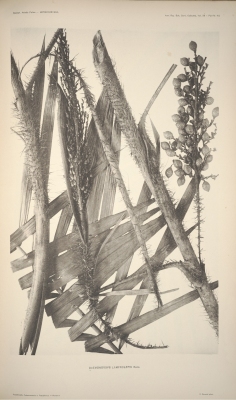Daemonorops lamprolepis
Becc.
Arecaceae
It has been proposed - William J.Baker; A revised delimitation of the rattan genus Calamus (Arecaceae), Phytotaxa 197 (2): 139-152; 2015 - that the genera Ceratolobus, Daemonorops, Pogonotium and Retispatha should all be subsumed into a revised and expanded concept of the genus Calamus. This revised treatment has been accepted in the 'World Checklist of Selected Plant Families' and is likely to recieve further acceptance. For the time being, until there is wider acceptance of this change, we are not moving these species across into Calamus. The new name for this species in Calamus will be Calamus lamprolepis (Becc.) W.J.Baker[
K- Title
- Plants for a Future
- Author
- Ken Fern
- Description
- Notes from observations, tasting etc at Plants For A Future and on field trips.
].
Calamus lamprolepis (Becc.) W.J.Baker
Common Name:

Botanical specimens of the plant
Photograph by: Annals of the Royal Botanic Garden Calcutta. Vol. 12, Pt. 1 1908

General Information
Daemonorops lamprolepis is an evergreen, climbing palm producing a cluster of unbranched stems that climb into the surrounding vegetation[
548- Title
- Annals of the Royal Botanic Garden Calcutta. Vol. 12, Pt. 1
- Publication
-
- Author
- Beccari O.
- Website
- http://www.biodiversitylibrary.org
- Publisher
- Bengal Secretariat Press; Calcutta.
- Year
- 1911
- ISBN
-
- Description
- A monograph of the genus Daemonorops. It can be downloaded from the Internet.
].
The stems are harvested from the wild for local use as a binding material.
Known Hazards
None known
Botanical References
548- Title
- Annals of the Royal Botanic Garden Calcutta. Vol. 12, Pt. 1
- Publication
-
- Author
- Beccari O.
- Website
- http://www.biodiversitylibrary.org
- Publisher
- Bengal Secretariat Press; Calcutta.
- Year
- 1911
- ISBN
-
- Description
- A monograph of the genus Daemonorops. It can be downloaded from the Internet.
Range
Southeast Asia - Indonesia.
Habitat
Not known
Properties
| Other Uses Rating |      |
| Habit | Evergreen Climber |
| Height | 0.00 m |
| Cultivation Status | Wild |
Cultivation Details
Most species in this genus are more or less vigorous climbing plants in rainforests. In general, they are likely to grow best with their roots in the shade but with enough gap in the canopy to encourage their stems to grow up towards the light. They are also likely to grow best in a humus-rich soil[
K- Title
- Plants for a Future
- Author
- Ken Fern
- Description
- Notes from observations, tasting etc at Plants For A Future and on field trips.
].
A dioecious species, both male and female forms need to be grown if fruit and seed are required.
Edible Uses
None known
Medicinal
None known
Other Uses
The stems are used locally as a binding material[
310- Title
- Plant Resources of Southeast Asia
- Publication
-
- Author
-
- Website
- http://proseanet.org/
- Publisher
-
- Year
- 0
- ISBN
-
- Description
- Lots of information on the uses of the plants of SE Asia.
]. The sheathed stems are about 2cm in diameter[
548- Title
- Annals of the Royal Botanic Garden Calcutta. Vol. 12, Pt. 1
- Publication
-
- Author
- Beccari O.
- Website
- http://www.biodiversitylibrary.org
- Publisher
- Bengal Secretariat Press; Calcutta.
- Year
- 1911
- ISBN
-
- Description
- A monograph of the genus Daemonorops. It can be downloaded from the Internet.
].
Propagation
Seed -
If you have any useful information about this plant, please leave a comment. Comments have to be approved before they are shown here.
 Useful Tropical Plants Database 2014 by
Ken Fern,
web interface by
Ajna Fern
with help from
Richard Morris.
Useful Tropical Plants Database 2014 by
Ken Fern,
web interface by
Ajna Fern
with help from
Richard Morris.